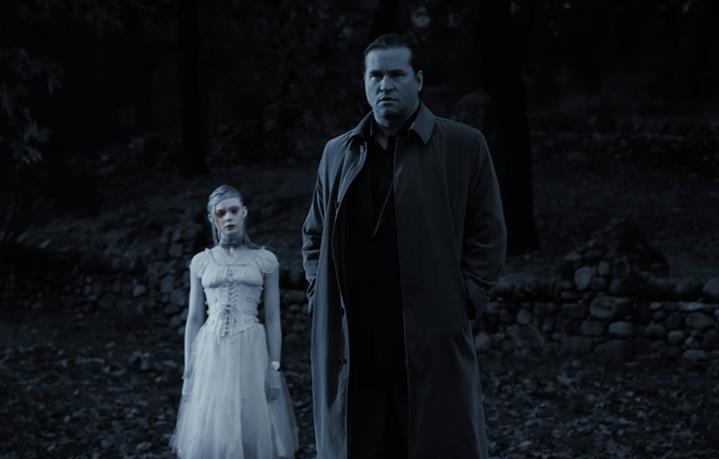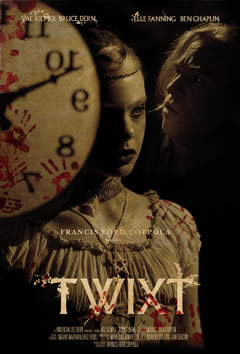Francis Ford Coppola returns with a stylistic departure and a self-conscious foray into the surreal, taking a swipe at the rise of supernatural fiction along the way.
[stextbox id=”grey” caption=”Twixt (2011)” float=”true” align=”right” width=”200″]
Director: Francis Ford Coppola
Writer(s): Francis Ford Coppola
Runtime: 90 minutes
Starring: Val Kilmer, Elle Fanning, Bruce Dern, Ben Chaplin, Tom Waits
Distributor: Pathé
Country: US
Rating: Better Than Average Bear (?)
[/stextbox]
It may have taken him decades, but the director of such classics as The Godfather, The Conversation and Apocalypse Now has once again become the experimental filmmaker promised in 1963’s Dementia. Following the self-distributed Tetro, Francis Ford Coppola has gone down that same path again with Twixt, a film that caused a buzz when it asked potential viewers to choose from a number of different posters for the film.
The gimmickry around the film was coupled with the Toronto International Film Festival premiere, which asked audiences to don 3D glasses during certain scenes of the film. For the European release of the film, the gimmickry is gone and we are left with a gothic vision that is not exactly straightforward, but compelling nonetheless.
Hall Baltimore (Val Kilmer), a “bargain basement Stephen King”, arrives in the isolated town of Swan Valley for a book signing. Disillusioned with the industry, he has turned to heavy drinking as a way of drowning out the pain of the loss of his daughter. His only motivation is persistent debt, something his wife never ceases to remind him of. Despite the tour of the strange town being a misfire, he meets the eccentric local Sheriff (Bruce Dern), who wants to work with him on a vampire book about the historic mass murder in the town. Coupled with that he has a doozy of a victim in the morgue: a young girl with a large wooden stake driven through her heart. After a haunting dream involving the ethereal goth V (Elle Fanning), Hall decides to collaborate with the sheriff, uncovering even more strangeness in the town.
Twixt is one of Coppola’s most conscious and personal pieces of filmmaking to date, and you can almost see the cogs working throughout its all too brief running time. Coppola doesn’t simply conjure up a gothic sensibility, but rather makes Edgar Allan Poe (Ben Chaplin) a central guide in Baltimore’s dream world. Yet it is almost a parody of this genre as well, from the gravelly Tom Waits voiceover describing the town’s multi-sided clock tower to the exaggerated style of acting that the players necessarily fall into. This gives the film a wickedly dark comic element, poking fun at the weighty melodrama that vampire fiction has transformed into. Yet at the same time, one of the central ‘ghosts’ of the film is the death of the protagonist’s daughter in a speedboat accident, mirroring the filmmaker’s own loss of his son Gian-Carlo to a boating accident in 1986.
Swan Valley is more Twilight Zone than Stephen King, and is designed to always keep audiences slightly off balance. The acting style is in sync with the look of the film, reminiscent of Robert Rodriguez’s Sin City during the dream sequences. In daylight hours, Mihai Malaimare Jr’s stunningly crisp cinematography echoes Twin Peaks, another series that Twixt owes a debt to. However, it is in the nocturnal wanderings of Hall Baltimore that the film really comes alive (so to speak), captivating with Poe’s tales of mystery and imagination, a ritual murder and the enigmatic cult figure Flamingo (Alden Ehrenreich) who lives on the other side of the lake.
Perhaps Twixt is merely Coppola exorcising some of his own personal demons, or maybe he has simply been inspired by the skilled filmmaking of his own children. The pieces don’t always click together, and the fine line between parody and just plain ridiculous bends on a regular basis, but it never breaks. Twixt is the message of a filmmaker renewed, and while he doesn’t quite find the “bulletproof ending” that his novelist character seeks, he is now at a point where he is ‘twixt one stage of his filmmaking life and the next.
Twixt was released in France on 11 April 2012 from Pathé. At the time of writing, is yet to receive a US or Australia release date.






